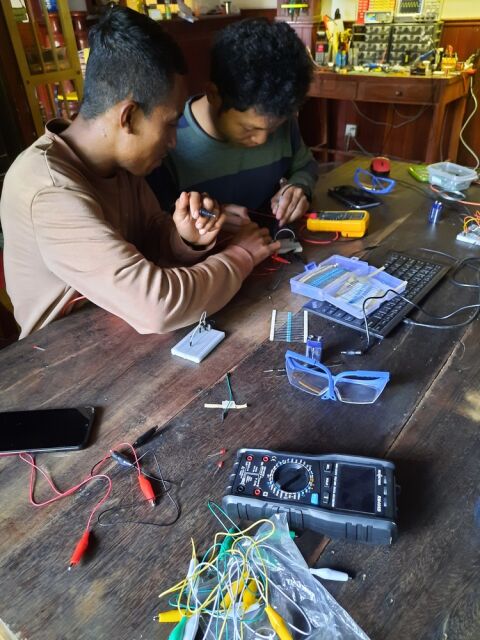Updated:
It has been a while since I started my electronics basic class for local students. I have four students, most of them knew nothing about electronics, or programming. On every weekends, I teach them in a two-hours class.
The course started from the very basic of electronics, like voltage, current, and resistance. They made a circuit on a breadboard, learnt how to use multi-meters, how LEDs work, and tried soldering pins on a universal board. It was the last week when they made their first program on a micro computer.

The goal of the class is: understanding circuit basics, and programming a simple code that accepts inputs — sensors and switches — and control external components. In other words, becoming a maker.
Some resources I am using in the class:
- Simple Circuits & Measurements Fundamentals, kindly provided by University of Colorado Boulder for learning electronics basic
- CODE.org for teaching very basic idea of programming to programming beginners
- tinkercad.com for Arduino programming and simulator
- makecode.microbit.org for Micro:bit programming and simulator
Four, or five at most, students attend the class. Students are expected to bring their own computers, but I have a computer for a student. All other materials and equipment are provided for free. Two one hour classes and a ten-minutes break in-between.
You can read an overview of the course at Electronics Basic Course page.
While I am teaching them, I am also learning because I am not a teacher in any way. Understanding something does not mean being able to teach it. As it was several decades ago when I was a beginner in programming, I don’t know where they stuck in programming. In that sense, the class is my own opportunity to learn how to teach.
Some findings in the class
Theories — while they are important — are boring. You cannot avoid the Ohm’s law, but it is easier for students to learn and practice it in a real circuit when they need it.
Students love something that can show their achievements. However simple, it is best to build something that does it.
They love using their own hands: they enjoy breadboarding and soldering more than anything else.
You have to be very careful while they are experimenting, especially when playing a live circuit. Battery should be used in that case to prevent accidents and injury, not PSU or bench power source.
Use small USB power banks when a circuit needs power from USB cable, instead of powering from a laptop. A short-circuit can kill the laptop. I use several 1-cell 18650 power banks.
Where to go from here
Firstly, having more students. The challenge is that it is extremely difficult to teach even a few students. Watching for potential dangers is one thing, taking care of students at different skill levels is another.
Secondly, another classes for students with basic knowledge to build a working project, such as a switch with a PIR motion sensor. The class should have a lesson to teach 3D modeling and printing objects.
Lastly, teaching networking-enabled devices, such as ESP32, including basic networking and TCP/IP. That would be the most challenging.
Stay tuned for updates!
